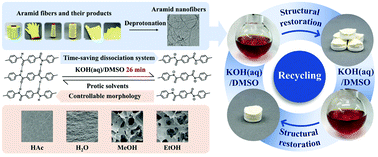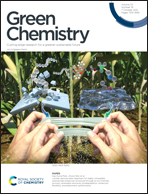Ultrafast, cost-effective and scaled-up recycling of aramid products into aramid nanofibers: mechanism, upcycling, closed-loop recycling†
Abstract
Aramid fiber products have been widely used in both civil and military fields. However, the improper disposal of waste aramid fiber products could result in potential environmental problems and waste of valuable resources. In comparison with mechanical recycling, recycling of aramid fibers into aramid nanofibers (ANFs) as a novel 1D building block for functional materials has better development prospects and has got greater attention. However, the time-consuming preparation cycle of the existing approaches is not conducive to rapid and large-scale production or an in situ study of the mechanism. Herein, based on the in situ size control of solid KOH, a proton donor-assisted deprotonation system for both Kevlar fibers and their various products, i.e. KOH(aq)/DMSO system, was developed to prepare ANFs with a well-defined and uniform structure. Through this novel deprotonation system, not only is the preparation time of 0.2 wt% ANFs greatly shortened to 26 min (a tenth of the time of the state-of-the-art technology) but also the production of ANFs with high concentration (4.0 wt%) and in large amounts (1500 mL) can be realized within several hours. Importantly, the deprotonation process of Kevlar fibers as well as the formation mechanism and structural restoration of ANFs were studied by in situ characterization methods. In addition, the controlled preparation of ANF aerogels with diverse microstructures was realized by the structural restoration of ANFs under different protic solvents and subsequent lyophilization, and the physical properties of ANF aerogels were investigated. Significantly, the various Kevlar products and ANF aerogels both can be rapidly and highly efficiently dissociated to ANFs, undoubtedly demonstrating the proof-of-concept for recycling of waste aramid products and closed-loop recycling of ANF-based materials. Therefore, this work not only offers a better understanding of the mechanism of both the deprotonation of aramid fibers and the restoration of ANFs, but also provides a highly feasible, highly efficient and cost-effective recycling strategy of waste aramid products and ANF-based materials.



 Please wait while we load your content...
Please wait while we load your content...